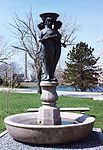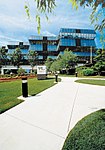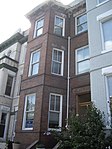McMillan Sand Filtration Site

McMillan Sand Filtration Site is a twenty-five acre decommissioned water treatment plant in northwest Washington, D.C., built as part of the historic McMillan Reservoir Park. It is bound on the north by Michigan Avenue, on the east by North Capitol Street, on the south by Channing Street and on the west by McMillan Drive; which runs along the edge of the reservoir, to which it was formerly attached. Two paved courts lined by regulator houses, tower-like sand bins, sand washers and the gated entrances to the underground filter cells provided a promenade for citizens taking the air in the park before it was fenced off in WWII. Below grade, there are twenty catacomb-like cells, each an acre in extent, where sand was used to filter water from the Potomac River by way of the Washington Aqueduct. The purification system was a slow sand filter design that became obsolete by the late 20th century. In 1985, a new rapid sand filter plant replaced it across First Street beside the reservoir. The treatment system is operated by the Army Corps of Engineers. Public access to the site has been restricted since World War II, when the Army erected a fence to guard against sabotage of the city's water supply. Until recently, specially arranged biannual tours were arranged for scores of visitors curious about the odd-looking structures. The site was never reopened to the public on the same basis as before the war. In 1991, the D.C. Historic Preservation Review Board designated McMillan Park a Historic Landmark and nominated the site for the National Register of Historic Places. It included the site on their "List of Most Endangered Properties in 2000" and again in 2005.
Excerpt from the Wikipedia article McMillan Sand Filtration Site (License: CC BY-SA 3.0, Authors, Images).McMillan Sand Filtration Site
Michigan Avenue Northwest, Washington
Geographical coordinates (GPS) Address External links Nearby Places Show on map
Geographical coordinates (GPS)
| Latitude | Longitude |
|---|---|
| N 38.924472222222 ° | E -77.010472222222 ° |
Address
McMillan Sand Filtration Site
Michigan Avenue Northwest
20422 Washington
District of Columbia, United States
Open on Google Maps








